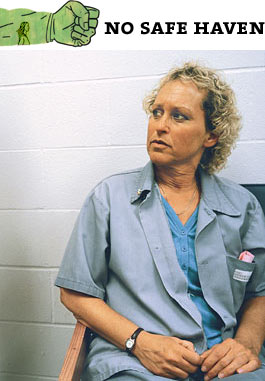
Photos: <a href="http://www.magnumphotos.com/" target="new">Susan Meiselas/Magnum</a>
JOE CHURCH HAD NOT EVEN PLANNED TO go to his 20th high school reunion. At the last minute, he changed his mind and dropped by the Irish bar in downtown St. Louis, where 70 or 80 classmates from Mercy High School had gathered. Back in the mid-1970s, Joe had been the sort of student who showed up for school late and left early, a regular visitor to the discipline office. By the time of the reunion in the summer of 1997, he had a wife, four children, and a job as a stockbroker at Morgan Stanley.
After half an hour of drinking and mingling, Joe spotted Shelley Povis’ cousin. In high school, Shelley had been pretty and popular; she had a spot on the football cheerleading squad and friends in every clique. She and Joe had never been close, but he remembered her as always smiling, always fun to be around.
“Where’s Shelley?” he asked.
“She’s in prison,” her cousin said. Joe hadn’t seen Shelley since graduation; the news stunned him. What sort of crime could she possibly have committed? Drugs? Bad checks? Shoplifting?
“She killed her husband,” her cousin said.
Joe stayed at the reunion for a couple hours, then drove back to his house in the suburbs. Alone in his car, he tried to make sense of the news. A few days later, he sent Shelley a note and shortly after spoke with her on the phone. Shelley told him that she’d married an alcoholic who had abused her throughout their 14-year marriage. Three years ago, she’d confessed to killing him; a judge had sentenced her to 15 years in prison. “I was really taken aback with the whole thing,” Joe says. “It was just hard to believe that, one, she could kill somebody, and two, under those circumstances she could’ve ended up in prison.”
Eventually, one Saturday, Joe drove two and a half hours across the state to visit Shelley in prison; the next week, back in his office, he started making calls. He spoke with Shelley’s mother, her former boss, the police. There was no doubt that Shelley had endured many years of beatings. The photos taken by the police after her arrest showed a woman he barely recognized, her face purple and black. “You don’t have to look at those pictures very long to realize that something terrible was happening,” he says. “How does a guy look at her and say, ‘You’re a murderer.’ I just didn’t understand.”
One of the first people Joe called was Colleen Coble, head of the Missouri Coalition Against Domestic Violence. He had dated her one summer when they were teenagers, but they hadn’t spoken in 10 or 15 years. On the phone, he was full of questions about how to launch a clemency campaign: “What are we going to do? How much money do I need to raise? Who do we need to contact?” His zeal did not surprise her. “He has a finely honed sense of right and wrong,” she says, “and in that sense is the good Catholic boy his parents raised.”
Joe moved quickly. He expanded his mission, compiling a list of women who might be good candidates for clemency. Then Colleen got a meeting for them with Governor Mel Carnahan’s legal counsel. They were told that if they could gather more information about these women’s cases, the governor would take a look at them. She contacted local law schools, and the Missouri Battered Women’s Clemency Coalition was created. Soon every law school in the state had joined. Professors took up the cause in legal clinics, assigning students to reinvestigate cases of women who were in prison for killing their abusers.
One of the successes of the domestic violence movement has been its ability to publicize the plight of battered women serving prison time for crimes related to their abuse. Since 1978, the nation’s governors have granted clemency to more than 125 women convicted of killing (or ordering the killing of) their abusers. The largest group of clemencies took place in Ohio in 1990, when Governor Richard Celeste commuted the sentences of 25 women, explaining that they were “victims in a profound way and were prevented from giving evidence…essential to a jury’s being able to reach a sound verdict.” When he was governor of Missouri, John Ashcroft granted clemency in 1992 to two women who said they’d killed their husbands in self-defense.
The subject of domestic violence has receded from the headlines in recent years, but the numbers suggest it’s still a major social problem. While services for battered women—including hot lines and shelter beds—have increased dramatically, there are still not enough; 4,237 adults and children were turned away from domestic violence shelters in Missouri last year because there was not enough space, according to Colleen Coble. Even when services are available, some women are too terrified to use them. Fleeing from a batterer can actually increase the violence a woman faces; many of the 1,202 women killed by their husbands or boyfriends in the U.S. in 2002 were murdered after they’d already escaped from their homes.
While Joe Church was the catalyst for Missouri’s latest clemency movement, his own priority was always the same: to get clemency for Shelley. Neither he nor the lawyers he had enlisted had any idea how long their fight would go on. All they really had was an unshakable belief that Shelley and many other women who had killed their abusers never deserved the harsh punishments they’d received.

Joe Church, Shelley’s friend and advocate, in his Morgan Stanley office
SHELLEY POVIS GREW UP in St. Ann, a blue-collar suburb west of St. Louis. When she was 17 and a senior at Mercy High, she began dating Rodney Hendrickson. She liked the fact that he was almost four years older. He hung out with her uncle and cultivated a bad-boy persona, growing his hair long and zooming around town on a motorcycle. According to the neighborhood grapevine, he had smacked around his last girlfriend. Shelley’s mother, Mickie, tried to dissuade her from dating him, but Shelley wouldn’t listen. “He’s really not a bad guy,” she said.
Shelley and Rodney got married in 1980, when she was 21. She worked as a waitress; he got a job with the gas company. From the beginning, he kept her under surveillance. He would check on her all the time, calling or stopping by her job to make sure she was there. He also paid close attention to her appearance. If he thought another guy was checking her out, he’d get angry. Soon he was picking out her clothes for her—always modest items that would discourage other men. “I thought it was kind of neat,” Shelley recalls. “I thought, wow, this guy wants to pick out my clothes. He really loves me.”
Rodney was a heavy drinker, and when he got drunk he could become aggressive. Occasionally he would smack Shelley, or grab her and shake her. “A lot of it I thought was my fault,” she says. It was impossible to predict when he’d lose his temper. She could be sitting next to Rodney watching television, and the next thing she knew he would be hitting her. After each fight, he apologized and tried to win her back. “He’d buy me gifts and flowers,” she says. “There would be periods when he would treat me like a queen.”
Eight years into the marriage, Shelley decided she’d had enough of Rodney’s drunken rages. By now they had three children. She moved out, taking the children with her.
At first Rodney didn’t know where she’d gone, but after four weeks he tracked her down at a shelter for battered women. She walked out the back of the shelter one day, and there he was, sitting in his truck. “You need to come home now,” he told her. “If you don’t go in there and get your stuff, I’m going to go in and get it.” As usual, he made promises about how he had changed, how he was drinking less, how he wouldn’t hit her anymore. Shelley and the children moved back into their house.
In the years that followed, Rodney warned Shelley never to run away from him again. “He told me if I ever left again, he would hunt me down,” she says. She knew him well enough not to take this threat lightly. When she’d been at the shelter, he’d called her mother all the time, begging for information about where she was. Shelley worried that if she ever left Rodney again, she’d put not only herself and the children at risk, but her mother, too.
She hid these fears from her family, just as she had hidden the evidence of Rodney’s abuse. She tried hard to project the image of a happy marriage, avoiding her relatives whenever she had a black eye or a bruise. “When we had a barbecue planned and I talked to her the day before, she’d say, ‘Yeah, I’m going to bring the potato salad.’ And everything was fine,” her mother recalls. “That would be Saturday. And Sunday morning she’d call and say one of the kids was sick, or she was sick, or she just didn’t show up.”
During the summer of 1993, the Missouri and Mississippi rivers overflowed. It was the most devastating flood in recent history and damaged more than 55,000 homes, including Rodney and Shelley’s. The entire interior of their house was destroyed, filled with slime and river water. Now they had four children and nowhere to live. They moved into Shelley’s mother’s basement for a few months, then into a tiny apartment, which was all they could afford. The stress mounted. Shelley and the children spent hours in emergency relief lines, trying to get free clothes or building materials. Rodney worked days driving a delivery truck, then at night rebuilding the house.
In November 1993, Shelley got a job as a weight-loss consultant. One day she showed up with a bruise stretching from one ear, across her throat, and all the way to her other ear. Another time her boss saw a dark spot the size of a dinner plate on Shelley’s thigh. At first Shelley blamed her own clumsiness, but eventually she told the truth. When her boss urged her to leave Rodney, Shelley said she was afraid that if she did, he would hunt her down and kill her.
Shelley and Rodney moved back into their house in the summer of 1994, after living elsewhere for nearly a year. By now, they never seemed to have any good days anymore. Rodney had stopped trying to woo her back with gifts every time he hit her. “I wouldn’t even get an ‘I’m sorry,'” she says.
One day in the fall of 1994, he threatened her with a hunting knife. Afterward she hid the knife; Rodney became furious. “He had me up against the wall, choking me, telling me that I better have his knife when he got home from work or he was going to kill me,” she says. Shelley pleaded with him to let her leave with the kids, but her words only made him more angry. “None of you are leaving,” he said. “I’d rather see you all dead than leave.”
Their 11-year-old daughter, Ashley, overheard this argument. After Rodney left the house to go to work, Ashley said something Shelley found very disturbing. “She told me that he would come in and go to the bathroom when she was in the bathtub and watch her,” Shelley says.
The following week, on October 29, Shelley drove to Kmart and bought a 12-gauge shotgun.
WHEN POLICE OFFICERS walked into the Hendrickson home at 2:45 a.m. on October 31, 1994, they found Shelley in her nightgown, curled up in the fetal position on the floor. She had a swollen eye, a bruise on her forehead, and tears running down her cheeks. Tied to one of her wrists was a piece of rope. Ashley was on the couch next to her; the three other children were in their rooms. In the master bedroom, the officers found Rodney facedown on the bed. Blood spattered the wall next to him. One of his eyeballs was on the floor. There was a gunshot wound in the back of his head.
At first Shelley insisted a pair of masked men had broken in, tied her to the bed, and shot Rodney. Three hours later, hunched over a table in an interrogation room at the police station, she confessed to the murder. Earlier that night, she explained, after the children had gone to sleep, Rodney had grabbed her by the hair, smashed her head against the headboard, and tied her wrists to the bed. Then he raped her. After he fell asleep, she’d freed herself and reached under the bed to get the shotgun.
An autopsy later revealed that at the time of his death Rodney had a large amount of cocaine in his system. The police found the shotgun in the basement, in a portion still filled with water from the flood 16 months earlier. They found the rest of the ammunition in another part of the basement, hidden in a box with Christmas lights.
During the police interrogation, Shelley admitted lying about more than just the masked men. Two days earlier she’d called 911 and made a false report, claiming that someone had stolen her new shotgun. She had fabricated this story, she insisted, to steer Rodney off course if he found out she’d purchased a weapon. Why had she decided to buy a gun in the first place? “To protect myself,” she said.
The masked men, the stolen gun, the false report she filed with the police—all of these made-up stories undermined Shelley’s credibility in the minds of the officers. “Based on these circumstances, I told Michelle that I was having a hard time believing anything she told me,” one sergeant wrote in his report. To someone who knew her history of abuse, Shelley’s fabrications might have looked very different—evidence of her desperation as she increasingly felt her life was in danger.
Shelley was taken to the county jail and charged with first-degree murder. Her bail was set at $1 million. Six weeks later, during a preliminary hearing, an expert on battered women testified that Shelley had endured nearly 20 years of abuse and that she was not a threat to society. In another county, a better understanding of the psychology of domestic violence victims (combined with the way Shelley’s face looked when she was arrested) might have convinced the prosecuting attorney to charge her with a less serious crime—manslaughter, say, instead of murder. But the prosecutors in St. Charles County, a conservative area outside St. Louis, did not budge.
Shelley’s children—ages 11, 8, 7, and 5—moved in with one of Rodney’s sisters. Shelley’s first choice, her own sister, had no room in her house since she already had five children of her own. Shelley spent the next two years in the county jail, trying to figure out what to do. If she went to trial and lost, she’d likely spend the rest of her life in prison. In the end, she decided to plead guilty to second-degree murder in exchange for a 15-year prison sentence. She would be eligible for parole in about 13 years. By then all four of her children would have grown up without her.
PROFESSORS AND STUDENTS at four law schools across Missouri worked throughout most of 1999 and 2000 preparing clemency applications. They sorted through dozens of cases and came up with 11 women they thought were good candidates. All met the same criteria: They had a history of domestic violence; they had been convicted of killing (or ordering the killing of) their batterers; they had received lengthy prison sentences; and they had exhausted all their legal appeals.
Of the 11 women, 5 had life sentences, 3 had to serve 50 years before they were eligible for parole, 1 had a 20-year sentence, and 2 (including Shelley) had received 15 years. The clemency petitions contended that the “presence of prolonged and sustained abuse” should have reduced the women’s culpability in the eyes of prosecutors and resulted in less severe punishments.
“These women are not what have been described as your ‘typical murderers,'” wrote Jane Aiken, a professor at Washington University School of Law, in a legal brief filed with the petitions. “They did not act with ‘cold hearts’: their acts are better characterized as final acts of desperation in the context of severe physical and sexual violence inflicted upon them.”
In this clemency campaign, Shelley played a crucial role. She recruited many of the women, including her friend Carlene Borden, who’d been locked up since 1978 in connection with her boyfriend’s murder of her abusive husband. Of the 11 women represented by the team of law professors, Carlene had been imprisoned the longest. Another candidate was Ruby Jamerson, who had been sent to prison in 1989 for asking her son and his friend to kill her abusive husband.
Much has changed since the 1970s and 1980s, when Carlene and Ruby were convicted. Now police officers are more likely to arrest an abusive husband when his wife calls the police. When a woman is charged with killing her batterer, the defense team often includes an expert on domestic violence. And judges are much more likely to allow testimony about past abuse. Indeed, as the clemency petitions pointed out, women accused of killing their abusers in the 1970s and 1980s would likely receive less prison time today for the same crime.
To bolster Shelley’s clemency application, her legal team collected 21 letters of support from members of her family and 36 from friends and former classmates at Mercy High. Nobody from Rodney’s family wrote on her behalf, but Rodney’s sister-in-law Melissa did write to Shelley’s lawyers, trying to dissuade them. “The fact of the matter is that Michelle Hendrickson is a murderer,” she wrote. “I don’t feel that after planning and premeditating a murder and shooting her husband in the head with a deer slug that she should be released after just 6 years.”
In the summer of 2000, Governor Carnahan was running for a seat in the U.S. Senate. Hopes were high that he might grant clemency to a group of women right before he left office, when elected officials are more likely to make this sort of politically risky decision. Then, on October 17, 2000, Carnahan died in a plane crash. The possibility that Shelley and the rest of the women would be let out of prison early suddenly seemed much less likely.
The team of law professors pressed on, turning their focus to Carnahan’s replacement, Lt. Governor Roger B. Wilson, who filled the top spot for 83 days. On the last day of Wilson’s short term, Shelley’s lawyer, Marie Kenyon, traveled to Jefferson City. “I followed his chief lawyer around the Capitol building the whole day, bugging him,” says Marie, an adjunct professor at Saint Louis University School of Law. “He was in his office, wrapping up his plaques, putting them in boxes, explaining to us why this wasn’t going to happen.”
Robert Holden succeeded Wilson as governor in January 2001, and nearly four years later, at the end of his term, the coalition finally had its first success. Holden commuted the sentences of two women represented by the coalition: Shirley Lute, 74, who had been locked up for 23 years, and Lynda Branch, 52, who’d been in prison for 18 years. Holden’s decision enabled them to go before the parole board this year; they are expected to be released soon.
At the end of 2004, Shelley received a letter stating that her request for clemency had been denied. There was no explanation. Now she must wait three years before she can reapply. “That’s one of the ridiculous things about this case,” says Marie. “It literally sat on the governor’s desk for almost five years, so that was five years of wasted time.”
ONE MORNING THIS SPRING, Shelley, who is now 45, told her story to a reporter while seated in the parole room at a prison in Vandalia, Missouri. She wore a gray inmate uniform and two crosses, one on a chain around her neck and another pinned to her collar. She still has curly blond hair, but now it’s thinner on top. Both her mother and grandmother had breast cancer, and two years ago Shelley discovered a lump in one of her breasts. She recalls that it took her five or six months to get treatment. Joe and her mother called the prison regularly, trying to speed up the process. “You could be jeopardizing her life,” Joe would say. Eventually Shelley had a lumpectomy, then chemotherapy and radiation.
These days, Shelley no longer sees bruises or black eyes when she looks in the mirror, but she can still see faint scars on her wrists, reminders of the rope burns she got when Rodney tied her to the bed. Though 11 years have passed since that last night with him, the memories are fresh in her mind. “I can still smell the smells,” she says—sweat, gunpowder, blood. “And I can still hear the sounds. I can still feel the hits. I can still feel every time my head hit that headboard. I can still feel the burns on my wrists.”
From behind the walls of prison, she tries to be a mother to her children, who are now 22, 18, 17, and 15. She calls them every Sunday evening at Rodney’s sister’s house, and her mother brings the youngest one to see her every month. But more than a year has passed since Shelley last saw her oldest child, Ashley. A few years ago, Ashley got into an abusive relationship, started using drugs, and got arrested. “Nobody knew where she was for over a year,” Shelley says. “She was living in a car.” The hardest part of being locked up, says Shelley, has been watching her kids struggle without her.
To boost Shelley’s spirits, Joe reminds her of what they’ve accomplished over the last eight years: Two women will soon be freed, including 74-year-old Shirley Lute. “This lady was destined to die there,” Joe says. “As I keep telling Shelley, had she not gone to prison, there’s a good chance Shirley Lute may never have gotten out.” Joe is planning a barbecue this summer to celebrate Shirley’s release.
Shelley is not eligible for parole until 2007, when she will have served 85 percent of her sentence. Most likely she will leave behind Carlene, Ruby, and the rest of the women who joined the clemency campaign. Unless a sympathetic governor intervenes, they are destined to grow old in prison.
















